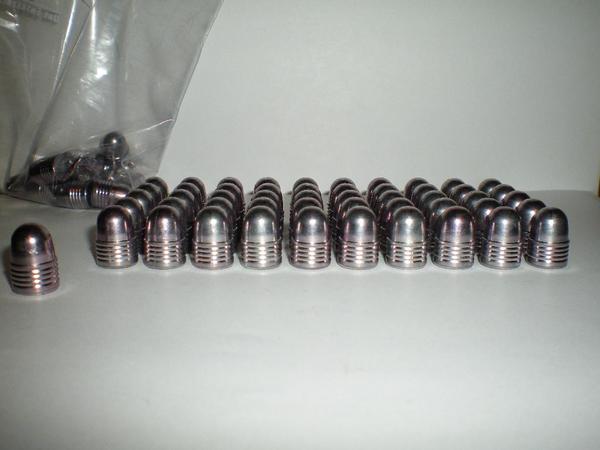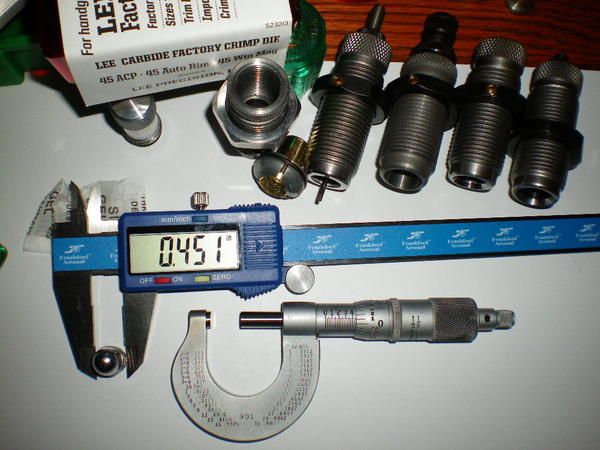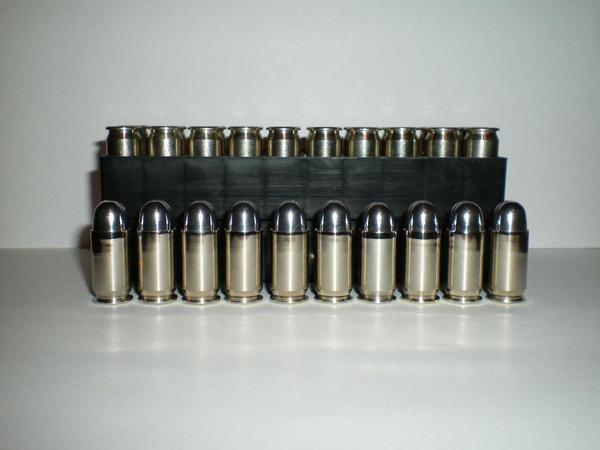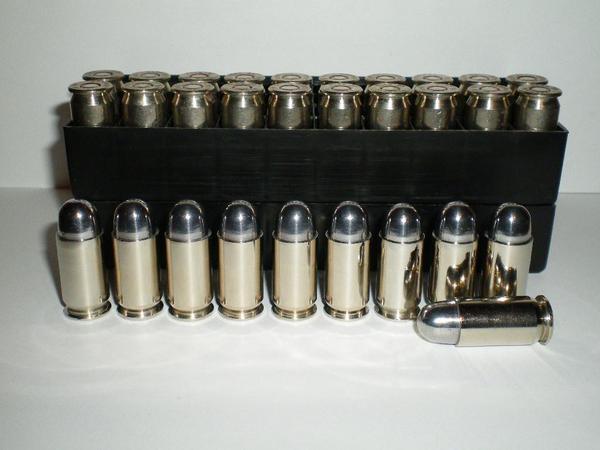November 11, 2012
 Offline
OfflineI've found the Lee Factory Crimp Die especially useful when loading the 357. As a matter of fact, I use these dies for every caliber I reload. (9mm, 38spcl, 357mag, 40S&W, 45ACP, and 223Remington). Like many of you; I had issues with poor crimps especially on the 357. The factory crimp die took care of the problem. I highly reccomend them. They will definitely help keep a good day at the range from going sour.
Mike

Dans Club
March 2, 2008
 Offline
OfflineMy son has convinced me to use the Lee factory crimp dies. I'm not experienced enough yet to know if they really make a difference, but he reloads a lot, for about a dozen calibers, and swears by them.
I went to a bookstore and asked the saleswoman "Were is the Self Help Section?" She said if she told me, it would defeat the purpose.
George Carlin

DWF Supporters

Dans Club

Moderators
November 17, 2008
 Offline
OfflineOK so I have to ask. I can't count how many reloads I have done over the years but have no experience with the LEE factory crimp die. I have done taper crimps and roll crimps, light crimps and heavy crimps, and sometimes no crimp at all. What is different about a "factory" crimp? If I have overlooked the obvious I will accept my thrashing.
LB
Wisdom is merely the realization of how little one knows, therefore I am wise.
February 21, 2011
 Offline
OfflineFirstly there are 2 utterly different "Lee factory crimp dies", one for what seem to be bottleneck rifle cases, & the other (called a "Carbide Factory Crimp Die"), for strait-wall pistol cases.
The rifle type uses a tapered collet to imprint or squeeze the case mouth into the callelure of the bullet.
The pistol type uses a carbide sleeve to "iron" the case walls & a seperate taper, or roll crimp type depending on the caliber.
I hope the die works as advertised because I have one on order! Supposedly the carbide taper crimp die is more forgiving about different case lengths & has a different internal profile from the older dies in the die sets. I'm hoping it will give me independant adjustment for bullet seating & consistent crimping without having to do the double adjustment I need to now because I seat & crimp with a single die. Partly this is to make the switch from jacketed hollow points to plated lead simpler too because of the different crimp required of the 2 kinds of bullet construction will be easier to adjust for.
If it makes a difference I'm using a 4-stage progressive press instead of a single stage type, so for me it won't involve yet another pass through the press, it'll just use the currently empty 4th station.
Matthew Quigley on handguns:
“I said I never had much use for one. Never said
I didn't know how to use it.”
Supporter
Range Officer

Moderators

DWF Supporters

Dans Club
December 4, 2011
 Offline
OfflineI have a Dillon XL 650 progressive press with a five position head. I use a seperate crimp die, all my Dillon die sets come with a crimp die. Is this Lee die superior to the Dillon crimp die? I've never had a problem with crimps, and even load for my semi auto pistols and haven't had any failure to feed issues. Just want to know if I'm missing out on something.
Anything worth doing is worth doing well.
My father
If a man designed it, and a man built it, then a man can fix it.
My grandfather

Dans Club
March 2, 2008
 Offline
OfflineHere's what Lee says regarding the pistol calibers:
http://leeprecision.com/reloading-dies/hand-gun-dies/lee-carbide-factory-crimp-die/
I'm not expert enough to understand this fully, I'm just following instructions from my reloading mentor. So far it's working, I think.
I went to a bookstore and asked the saleswoman "Were is the Self Help Section?" She said if she told me, it would defeat the purpose.
George Carlin
February 21, 2011
 Offline
OfflineNot having tried the Dillon dies I don't have a way to compare the 2. I use RCBS which don't come with a crimp die seperate from the seater, so I'm trying to seperate the 2 functions.
Lee swears that thier design is less sensitive to case length, & as many of my cases are still under the suggested trim to length I don't want to trim further to uniform the length.
Matthew Quigley on handguns:
“I said I never had much use for one. Never said
I didn't know how to use it.”
February 26, 2012
 Offline
OfflineSteve, thanks for the link I've seen that before but it does give everyone a chance to read what Lee says about the die. I have a few thoughts though.
Remember, what is written at the link was written by an ad man who works for Lee.
If the die sizes the case as it crimps the case in the crimping groove wouldn't it resize the bullet at the same time since the bullet is inside the case? Now if the bullet is sized to the inside diameter of the case would it be too small to properly fit the bore?
If the length of the case is not critical to the die could it be the wrong length for the chamber of a semi-auto pistol? Since most semi-auto cartridges head space on the case mouth I've been taught that the cartridge length was some what critical. Have I been taught incorrectly?
In the case of a revolver cartridge if the case length isn't critical then would each crimp be slightly different there by giving a different bullet pull to each cartridge and giving radically different velocities? Wouldn't this be bad for accuracy?
In the case of Dillon dies with the separate crimping die Mike Dillon makes the claim that this enhances accuracy but DOES NOT claim that case length isn't critical.
I've use Dillon, Hornady, Lee, Lyman and RCBS dies (in alphabetical order only) and have produced excellent ammunition with them all. I have used the Lee factory crimp dies for bottle neck cases and found no difference in accuracy with or without. I don't advocate spending the extra money for the Lee die for that reason and for the reasons above. I don't use Lee dies anymore.
By all means do as you see fit this is my opinion and these are my questions.
Peace Bros.
Democracy is two wolves and a lamb voting on what to have for dinner. Liberty is a well armed lamb contesting the vote.

Dans Club
March 2, 2008
 Offline
Offlinepecos bill said
Steve, thanks for the link I've seen that before but it does give everyone a chance to read what Lee says about the die. I have a few thoughts though.Remember, what is written at the link was written by an ad man who works for Lee.
And if you actually read the Lee Reloading Manual, Lee has improved on everything any other company has ever done, and is the world class innovator in reloading. It's a little sickening, actually.
I went to a bookstore and asked the saleswoman "Were is the Self Help Section?" She said if she told me, it would defeat the purpose.
George Carlin
April 25, 2008
 Offline
OfflineNot to be a spoil-sport, but I've been using the Redding Profile Crimp Die for decades on all my straight-wall cases. Before that, I had problems with inconsistent crimps and poor accuracy. These work very well, giving much tighter, more uniform crimps, and accuracy has improved with their use. The first one I tried was for my .357 SuperMag, it worked so well I have bought one for all of my revolver handgun cases.
The Savantist

February 21, 2011
 Offline
OfflineWell I got a call last night that mine had arrived at the local gun store. I'm going to pick it up tomorrow & I'll give an honest review when I have a chance to examine & use it a little.
Unlike those who like (or don't like) a product based on opinion I'll give it a fair trial, who knows wether it'll rock or reek, I don't yet not having examined & used it.
Matthew Quigley on handguns:
“I said I never had much use for one. Never said
I didn't know how to use it.”
Supporter
Range Officer

Range Officers
May 2, 2009
 Offline
OfflineI'll give my 2 cents and a short answer....
I use the lee crimp dies in most of my handgun calibers. It is not sensitive to case length because it uses a floating crimper that adjusts to any case length. With a standard crimping die from say RCBS (all my stuff is mostlty RCBS) all the cases MUST be the exact same length to achieve equal crimps. I trim all my rifle cases, but I'm not about to trim 20,000 45 ACP cases every year ![]() ...
...
As far as the factory crimp dies--they are awesome. Especially in DW autos with a tight chamber. They smooth out the entire case to factory specs and eliminate any bulges (just like a bulge buster kit which I also have from lee).
SHOOT
February 21, 2011
 Offline
OfflineI picked up the die today & here's a preliminary report based on first impressions & hands on examination of the product. I have not used it as of now, so I can't yet honestly evaluate performance.
It came in a decent clear red plastic box with a 2-sided instruction sheet. The sheets instructions were clear & unambiguous if a little "hyped" on the wonderful awesomness of the item.
The die body seems well made & finished. The color is a little more silvery chrome-loking than my Dillon or RCBS dies. Wether that is cosmetic or material I don't know. The threads were well cut & had no bumps, grinds or snags over the entire thread length. The top portion (where you adjust the amount of crimp applied) seems to be some kind of alulminium alloy, not steel, like the die body. I don't know if this will lead to wear over time, but right now the threads on both engage fine & run smoothly.
Internally the carbide insert, steel crimp collar & so on are finished as well as any other die I've messed with. The floating crimp sleeve really does "float' indicating good machining tolerances. It behaves much like the floating seating die insert in my Hornady new dimension rifle dies.
My real reservation is with the "O"-ring locking used for both the die body in the press & the depth setting for the crimp ring. Time & test will tell. I left the crimp adjustment with the "O"-ring, but replaced the die lock ring with a screw-lock type.
More to follow when I actually run some round through it.
Matthew Quigley on handguns:
“I said I never had much use for one. Never said
I didn't know how to use it.”
February 29, 2012
 Offline
OfflineI have to state in advance that I really do like Lee dies. (other than the rubber O-ring which I tend to swap out with a standard lock ring)
And I do use Lee die sets often, as well as RCBS, Dillon, Redding dies, etc. and other brands of reloading dies.
My original plan was to purchase a .40S&W Lee Carbide Factory Crimp Die, to be used for a brass bulge buster kit. The price was pretty darn good for carbide dies, so I decided to get a handful of them, in most of the common calibers.
I have had no problems what so ever using the Lee Carbide Factory Crimp Die to assemble jacketed ammunition.
The Lee Carbide FCD has a carbide re sizing ring inside the die that full length sizes an already loaded cartridge after the crimping stage, to help assure that the loaded cartridge is correctly sized to SAAMI specifications, and that the cartridge will successfully chamber in your firearm.
If your loaded crimped cartridge is already the correct size, or undersize... Then the carbide ring does not even touch the brass, and the die will not re-size the cartridge.
Sounds great on paper right? Well as long as you don't mind full length sizing a cartridge twice. Of course if you load your cartridges correctly in the first place, It doesn't really happen, so is it even necessary?
My problems with the Lee FCD first appeared when loading over sized .452 diameter cast lead bullets in the 45acp cartridge.


When I assemble a loaded cast lead .452 cartridge in 45acp using the Lee FCD, the carbide ring in the die swaged, or squeezed down my over size lead bullet through the cartridge brass, making it too small. Pulling a bullet, and running a micrometer over the projectile quickly shows the problem.
I have an example pictured below.
This was a relatively hard bullet that was sized to .452 and cast from almost pure Linotype. While it pictures quite well, it's really unnecessarily hard for use in the 45acp cartridge. I loaded this round with the Lee FCD, and disassembled it using a kinetic bullet puller to measure the loaded projectiles diameter.
The Lee FCD has swaged down the hard .452 bullet, to .451 diameter. A typical soft.45acp alloy like 50/50 pure lead/wheel weight lead, or just even straight wheel weight lead has even less resistance to sizing spring back, and can potentially be swaged down more by the Lee FCD. (in extreme cases .450 or more)
Shooting an undersized cast lead bullet tends to result in barrel leading from gas leaks due to poor bullet fit, as well as poor accuracy. Removing the Lee FCD from my cast lead bullet loading regimen quickly makes this problem go away.
It seems somewhat counter productive to take the time to slug your barrel, and then size the bullet to fit the barrel, only to have the Lee FCD swage down your bullet thereby making it under size.
While the re sized.451 bullet loaded with the Lee FCD fits easily into a case check gauge...So do .452 bullets assembled using a normal RCBS taper crimp, or roll crimp.
The Lee FCD can also swage down oversize cast lead bullets in other calibers.9mm - .358 sized cast lead bullet swaged down to .355
38/.357Mag - .359 sized cast lead bullet swaged down to .356
40S&W/10mm - .402 sized cast lead bullet swaged down to .399-.400
44Mag - .433 sized cast lead bullets swaged down to .430 (really bad in 44 rifles)
The hardness of your bullet, as well as the thickness of the brand of cartridge brass can vary the amount of sizing down, from none to way too much. In the end I simply found it was easier to not use the Lee FCD with my oversize cast lead bullets at all.
The Lee FCD does however work great when assembling standard size jacketed ammunition, but then so do most of the other die brands.
I tend to take my time loading small batches of ammunition single stage to get things "just right" for my personal target shooting these days. I also gauge all of my loaded ammunition with a case check gauge, to assure that it will chamber. It helps catch any accidents before I am on the range.
If I still loaded large amounts of jacketed ammunition commercially, on automated or progressive re loaders, I might be tempted to use the Lee FCD as a safety check, sort of like a powder cop die to help assure that everything was in specification, but I don't anymore, so I don't really find the Lee FCD necessary for the type of hand loading that I do.
I have used a disassembled Lee FCD as a carbide full length push through sizer die, to remove the guppy, or bulge from brass that was fired in an unsupported chamber.
The Lee Carbide FCD is a useful loading tool for the assembly of jacketed ammunition, and can be a handy part of your reloading tool box, as long as you are aware of it's drawbacks when using it with over sized cast lead bullets.
- Bullwolf

Dans Club
March 2, 2008
 Offline
OfflineThanks. I'm a newer reloader, and I used the FCD because I've been told to. I haven't loaded much lead yet, mostly jacketed, but I do have a bunch of commercially cast lead for .45 that I'm getting ready to work with.
Now to take this off topic: I know what slugging the barrel is, but I've never known exactly how it's done. Anyone care to educate me? Most references are to a gunsmith slugging the barrel, but after that reference I am clueless (a fairly common state of affairs for me).
I went to a bookstore and asked the saleswoman "Were is the Self Help Section?" She said if she told me, it would defeat the purpose.
George Carlin
February 21, 2011
 Offline
OfflineSlugging a bore is basically forcing a soft oversized lead "slug" through the bore. After the lead has been swaged (squeezed) down to the tightest internal dimension by passing through the bore it is removed & measured as a kind of "negative image" of the bore.
Soft lead (the softer the better) is the trick, together with lots of lube everywhere & a good technique for pounding the lubed slug through the bore & catching it on exit. Usually short lengths of wood dowel are used (a single long one might bend or splinter in the bore) & a rubber mallet for the actual hammering. pure lead fishing weights that you can gouge with a fingernail are a frequent candidate as they are cheap, available & come in many cylindrical shapes.
Matthew Quigley on handguns:
“I said I never had much use for one. Never said
I didn't know how to use it.”
February 21, 2011
 Offline
OfflineIt depends on why exactly you're looking for an individual measurement. To calculate the size for swaged or cast bullets you measure the maximum diameter, to check things like rifling depth you measure maximum, minimum & subtract one from the other & diivide by 2.
Rermember though any measurement will be the minimum diameter throughout the bore. Just as an example lets say the bore is nominally .356 acrross the lands & .358 across the groves. However ther is a tight spot that occured during manufacturong where these are .001 tighter. The slug wil show .355 & .357 because it had to pass through the constriction.
Matthew Quigley on handguns:
“I said I never had much use for one. Never said
I didn't know how to use it.”
February 29, 2012
 Offline
Offlinemister callan said
Slugging a bore is basically forcing a soft oversized lead "slug" through the bore. After the lead has been swaged (squeezed) down to the tightest internal dimension by passing through the bore it is removed & measured as a kind of "negative image" of the bore.
Soft lead (the softer the better) is the trick, together with lots of lube everywhere & a good technique for pounding the lubed slug through the bore & catching it on exit. Usually short lengths of wood dowel are used (a single long one might bend or splinter in the bore)
Excellent advice.
I might add to the above quote, that if you must use wood, be sure to use a good solid piece of hard wood dowel. I personally prefer to use a short length of brass rod, much like I would use for a squib clearing rod to drive a slug through a barrel. I also like to wrap the brass rod in the front and back with some electrical tape, so the metal part of the rod doesn't come into contact the inside of the barrel. Think sort of like the O-rings on an Outers foul-out rod.
You can save yourself a lot of headache and hassle later on down the road by using something solid to push the slug, or a squib round through the barrel with.
It is definitely not fun to get a stuck bullet, or slug jammed in the bore, and then compound the problem with a broken piece of soft wood.
Generously lubricating the barrel that you plan on slugging, is also another good piece of advice.
It really isn't as complicated as it sounds to slug a barrel. Just lube it up, and pound the slug on through, it's not rocket science. People have been doing it for years, and it wont hurt the bore any to do so.
You do want to use a dead soft (pure) piece of lead if possible. Harder lead can "spring back" a bit, and tends to give you erroneous readings.
This is one of the reasons fishing lead weights are often suggested, just make sure that it really IS a lead weight, and not zinc, tin, or some other kind of harder environmentally safe alloy. If you happen to be a bullet caster, you can do close to the same thing from say stick on tape wheel weights, or plumbing lead usually.
Fishing sinkers just happen to be convenient, as they are already cast, and often close to the desired shape and diameter.
Another commonly used possible slug, is a slightly larger than caliber size muzzle loading ball, as they are often made from pure soft lead. The only downside to using muzzle loading balls, is that you typically have to buy more than you need or want (like a box of 100) to just get a single ball to slug your bore with.
If your potential slug is a little bit too small... Don't fret, you can give it a bit of a squeeze in a vice, or a whack it with a hammer to bump the size up a some for your desired application.
While slugging a bore, be sure to pay close attention to the felt resistance while driving the slug through the bore. If you notice that you have any tight or loose spots.....Consider slugging the bore from both ends. Simply push a slug in a few inches, then tap it out, and do the same from the other end. Measure both slugs, and then compare for any differences.
This way you can tell if the barrel has a constriction at some point, like say around the forcing cone, (from perhaps crush fit threads on a non Dan Wesson, or a heavy stamped roll mark) or the opposite, maybe an unseen bulge in the middle or what not.
- Bullwolf
1 Guest(s)

 Register
Register Log In
Log In Home
Home








